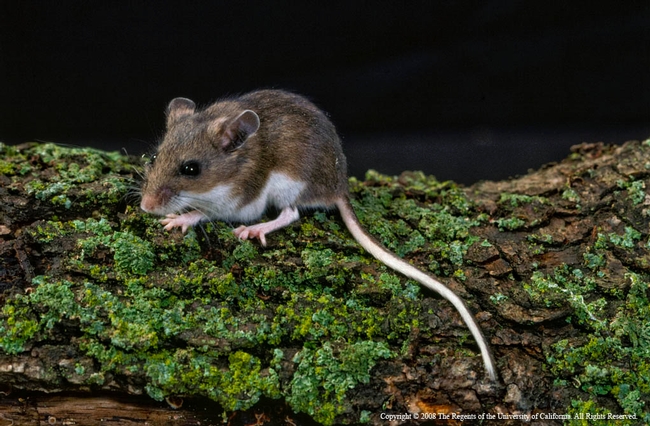
Recent cases of hantavirus a reminder to be mindful of deer mice

Hantavirus is a very rare but very serious disease. About one-third of cases identified in California are fatal, CDPH reports. Since hantavirus was first identified in 1993, there have been 60 cases in California and 587 cases nationally. The two recent cases bring the total California case count for 2012 to four.
Hantaviruses are a group of viruses spread mainly by deer mice. The UC Integrated Pest Management Program recently published a comprehensive online Pest Note about deer mice, which details identification, biology and behavior, damage and management. The publication says deer mice are the most abundant and widely distributed mammal in North America. Proficient jumpers and runners, deer mice were so named for their agility.
Because deer mice prefer forests, grasslands and agricultural crops, they aren’t normally found in urban and residential areas unless fields, forests or other suitable habitats are close by. Deer mice shed the hantavirus in their saliva, urine and droppings. A person may be exposed to hantavirus by breathing contaminated dust after disturbing or cleaning rodent droppings or nests or by living or working in rodent-infested settings. There is no evidence that North American hantaviruses can spread from one person to another.
The most effective way to avoid contracting hantavirus from deer mice is to keep them out of houses, cabins, and dwellings by rodent-proofing and excluding them from these structures by sealing all small gaps and cracks. Once deer mice infest a dwelling, it is critical to avoid working and sleeping in these areas until the infestation has been controlled and the area has been made safe for humans.
Before occupying an infested building, open the doors and windows to air out the room for at least 30 minutes. Where possible, use an electric fan on windowsills and in door entrances to assist the process. Be sure to vacate the building during the ventilation process to prevent inhaling aerosolized particles. Wearing a commercially available cloth or paper breathing mask offers some protection and is better than no protection at all. However, only an approved respirator equipped with high-efficiency particulate air (HEPA) filters offers total respiratory protection against airborne viruses.
It is important to wear nonfabric gloves (e.g., rubber, latex, vinyl, or nitrile) when cleaning deer mouse-infested buildings. Because humans can contract the virus by inhaling aerosolized deer mouse urine and feces, never stir up dust by vacuuming or sweeping or through any other activity.
To disinfect potentially contaminated areas, thoroughly wet trapped deer mice, droppings, and nests with an appropriate disinfectant solution such as Lysol or a 10% hypochlorite (bleach) solution. To make this bleach solution, mix 1 1/2 cups of household bleach in 1 gallon of water (or one part bleach to nine parts water). Note that a bleach solution may damage rugs and fabrics and irritate skin. Wear nonfabric gloves whenever touching or cleaning contaminated surfaces or when handling mouse nests, dead mice, or mouse traps.
Once everything has soaked for 10 minutes, remove all nest material, mice and droppings with a damp towel and then mop or sponge the area with the disinfectant solution. Upholstered furniture and carpets can be shampooed and steam cleaned. If you wish to reuse the gloves used while cleaning contaminated areas, you must properly disinfect them before removal. After removing the gloves, it is important to thoroughly wash hands with soap and water or use a waterless alcohol-based hand sanitizer when soap is unavailable and hands aren’t visibly soiled.
The UC IPM Pest Note on deer mice was written by Niamh Quinn, Evolution, Ecology, and Behavior, University of Liverpool, Liverpool, U.K., niamh.quinn@liverpool.ac.uk; Roger Baldwin, UC Cooperative Extension advisor, Statewide IPM Program, Kearney Agricultural Research and Extension Center, Parlier; and Bob Timm, director, UC Hopland Research and Extension Center,. For additional up-to-date information on rodent cleanup, visit the Centers for Disease Control and Prevention Web site, http://www.cdc.gov/rodents/cleaning/index.html.

Posted by art whitney on August 13, 2016 at 4:38 PM